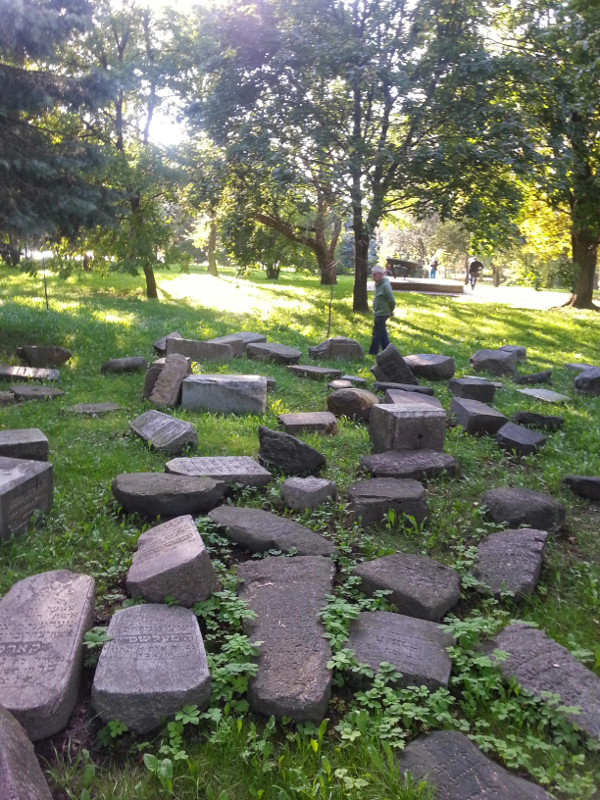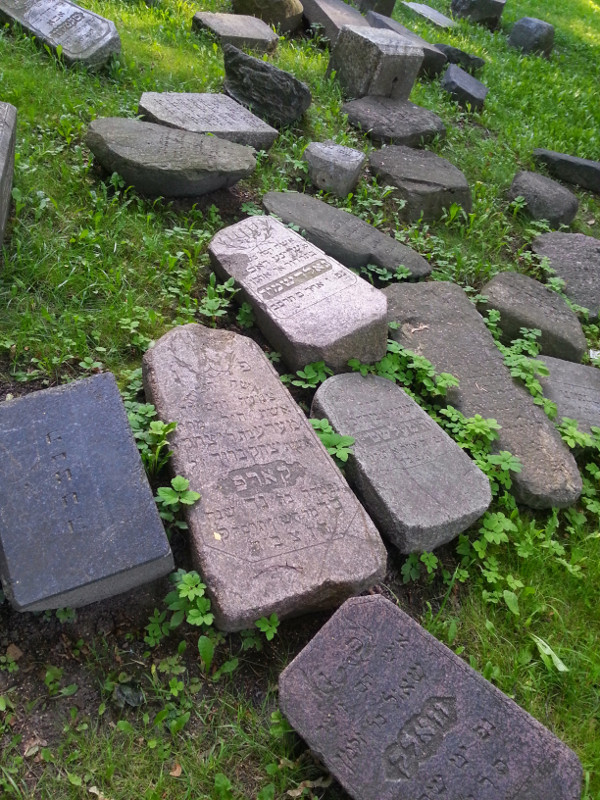Alternate names: Minsk [Rus, Yid], Mensk [Bel], Mińsk [Pol], Minskas [Lith], Miensk. Belarusian: Мінск. Russian: Минск. מינסק - Yiddish: 53°54' N, 27°34' E. Capitol. 1900 Jewish population: 48,000. ShtetLink. JOWBR Landsmanshaft: Roselawn, Toronto, Canada. Yizkors:Albom Minsk (Jerusalem, 1988); Minsk, Ir va-'em: Korot, Ma'asim, Ishim, Havai (Jerusalem, 1975-85); Getto Minsk ve-toldotav le-or ha-teud he-hadash (Ramat Gan, 2000) Town images and links.
Executive Director
East European Jewish Heritage Project
c/o Voluntas
P. O. Box 100
Minsk 220074
Republic of Belarus
Belarus Tel: +375 17 252 7314
Belarus Mob: +375 29 699 4016
Fax: +375 271 4736
London Tel: +44 20 7193 5474
Boston, MA Tel: +1 617 418 3202
www.voluntas.org
- Cemetery on Sochaya Street: "Unidentified assailants have smashed dozens of Jewish tombstones in Belarus, prompting Jewish activists to accuse Belarusian authorities Friday of inaction amid a string of anti-Semitic incidents. ... 19 tombstones destroyed at one cemetery in ... Minsk. ... Last week, more than 70 tombstones were desecrated in the city of Borisov east of Minsk, and police arrested some teenagers suspected of committing the attack... " Source: Ha'aretz English Edition: July 22, 2002-Av 13, 5762 [July 2002] images [March 2009]
photos of monuments to the German Jews killed in the outskirts of Minsk from 1941-1942. Two of massacre sites of Jews near a village Malyi Trostenets and memorials. Monument in memory of more than 200,000 Jews from Minsk and the countries of Western Europe near a village Malyi Trostenets. Massacre site of 5000 Jews of Minsk on March, 2, 1942 and memorial. photos of various Holocaust memorials [March 2009]
Yama: October 2008 memorial service News Article: Belarus Marks Ghetto's Destruction 65 Years On: "The Minsk ghetto, known as the Yama, or Pit, was one of Europe's largest. More than 100,000 Jews were killed there from August 1941. Most were shot in the street outside their homes. In October 1943, the Germans demolished ghetto buildings in an effort to find Jews in hiding. The remaining 2,000 Jews were rounded up and killed." [March 2009]
Yama : "In a large pit in the middle of town here, at a place called Yama, stands a monument dedicated to 5,000 Jews killed by the Nazis in that spot the day before Purim 1942. Erected in 1946, the monument was the first and only one in the USSR devoted to the Holocaust which displayed Yiddish writing. Remarkably, not only did the monument survive the efforts of Stalin to eradicate all traces of Jewishness, but it also became the only one in Belarus where Jews could legally gather without any interference from the government, which they did throughout the period of Communist rule. Today, the ditch has been expanded to include a walkway and plaza, trees planted for Righteous Gentiles. There is an evocative sculpture that stands on a slope parallel to the steps leading into the pit of Yama, depicting Jews being forced down into the ravine. A memorial ceremony was held there yesterday by emissaries of the Jewish Agency, who are here for their annual conference. We have thousands of monuments here in Belarus, and on most of them it says that 'Soviet citizens were killed here,' even if 100 percent of those killed were Jews," said Baruch Camil, head of the agency's operation in Belarus. "But this is the only one in Yiddish. It was something that kept the Jewish community together, whatever that 'community' was, where together they could do something as Jews, even during the time of Stalin and during the Communist period. I heard one of the Jews who came say, 'those who died here kept us alive as Jews.' "Source: [3 Jan 2001]
UPDATE: “The remains of 21 Jews who died of natural causes two centuries ago have been reburied, a few weeks after they were found beneath the central square in Minsk, Belarus. The remains of 11 men and 10 women were found by workers rebuilding the square on the site where a Jewish cemetery, closed since 1846, once stood.” Source: Dateline World Jewry, November 2002. [December 2002]
Hebrew website with photo. "taxes by the government in Lithuanian. Jews began to settle in the city in the 16th century. By Stephen Bathory -1579 King took the Jews to trade in approval. King Zygmunt's approval canceled -1606 Following a request from the Christians.But the Jews were released in -1609 and -1616 special solvents allowed them to deploy in their goods and -1629 to open stores. / Community Minsk was one of the founding communities of the Lithuanian Committee. Up to 1631 belonged to the Shire risk. During the war the Polish - Russian (1654-1667) Jews abandoned the city following the Russian conquest in 1655, but the return to Poland in 1658 returned to the Jews. Jews still did not have a permit to settle in and they were forced to rent houses Uniate, and thus suffered a double, for the hatred directed against Orthodox Christians, even the owners of homes and the Jews themselves. / Influence of the Vilna Gaon were established in several meetings. Late 19th and early 20th centuries was the center of Jewish labor movement. Rabbi in town served and lived famous rabbis, including: Rabbi Yechiel Halperin - author of "Order generations," Rabbi Yeruham Yehuda Leib Perlman called the big one from Minsk, "Rabbi Benjamin priest Kubizek called" Maggid of Minsk ", and Rabbi Gershon Tanchum Minsk (Rabbi Abraham Isaac Kook Learn to him some time before he arrived in Volozhin)). / Holocaust destroyed most of the Jewish community. In Minsk ghetto was established, which was the ghetto held longest occupied territories of the Soviet Union. Jews of the ghetto were several roundups killing huge pits dug near the villages T. Zinc and male Trustnitz'. Thousands of Jews from the ghetto fled into the nearby forests and fought there against the Germans (for example, a woman Bruskina). The last remaining Jews in the ghetto, who worked in forced labor were sent to their deaths in Sobibor death camp or shot to death in September - October 1943. Only 13 Jews survived the ghetto.Established in 1947, Zaslavsky street monument, the first of its kind in the Soviet Union, it reads: "Jews - victims of Fascism". The late 40s of the 20th century the city suffered harassment by the authorities of Jewish activity. January 1948 by KGB agents Assassinated the head of the Jewish theater Mikhoels, in 1949 the Jewish theater was closed and staff laid off, in 1959, the synagogue was the largest, and where he passed the Gorky Theatre. /60s forbidden burial in the Jewish cemetery, and then it was destroyed and became Dynamo stadium. In 1959 the Jewish population numbered 38 842 persons. During perestroika renewed community activities. There are currently two synagogues in Minsk of Belarus Jewish Federation - Ashkenaz, Chabad, and headed by the Chief Rabbi, Rabbi Schneur Zalman Belarus Deitch/ Saints buried in it: Rabbi Yechiel Halperin, author of GenerationsRabbi Moshe HirschRabbi Benjamin Makovsky. Rabbi Leib Perlman Yeruham. Rabbi Yehoshua Heschel ben Meir fortune MinskRabbi Yosef ben Yehuda Yudel IoskaRabbi Yitzchak ben Simcha Bunim Mizlis Rabbi Israel ben Yehuda Leib MirkisRabbi Moshe ben toil StaffRabbi Shaul ben Joseph [Apr 2014]
Photos courtesy This email address is being protected from spambots. You need JavaScript enabled to view it. [October 2014]
[UPDATE] Article from 2009 in Russian about Sukhara St. Cemetery
Translate.google.com renders the article into English [July 2017]
[UPDATE]
During the construction in the courtyard of the Belarusian State University were found gravestones from the Jewish cemetery.
The builders working on the construction of the new building for the Minsk Metro made an unexpected discovery. During the excavation work, fragments of Jewish tombstones were found. At this site, now known as the courtyard of the Belarusian State University, formerly located one of the Jewish cemeteries of the city.
The cemetery, which arose in the middle of the XIX century, existed before the construction of the University Campus of Belarussian State University in the second half of the 1920s. When the first university buildings were erected, some of the above-grave plates were underground and were recovered only after nearly a century.
Picture at https://realt.onliner.by/2018/


